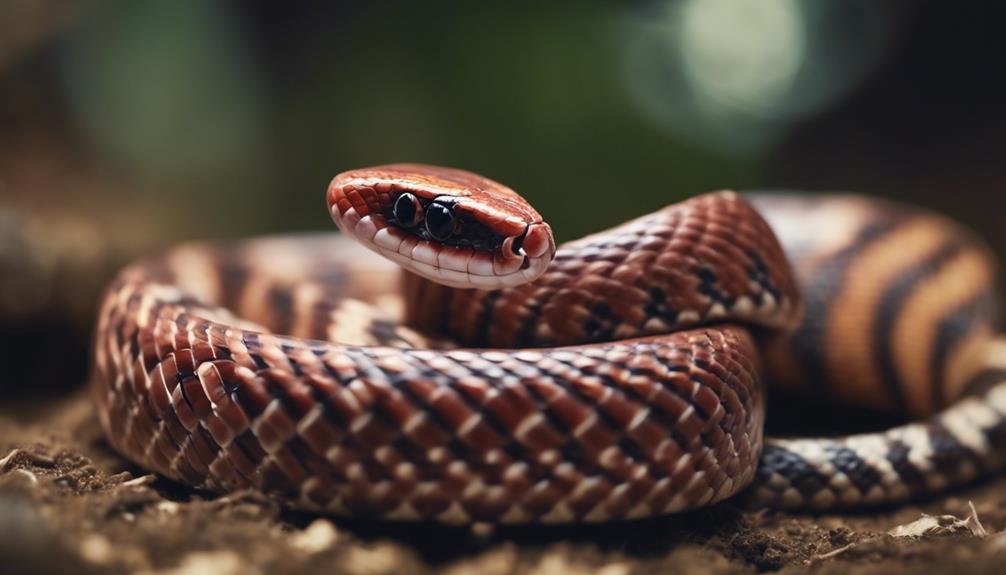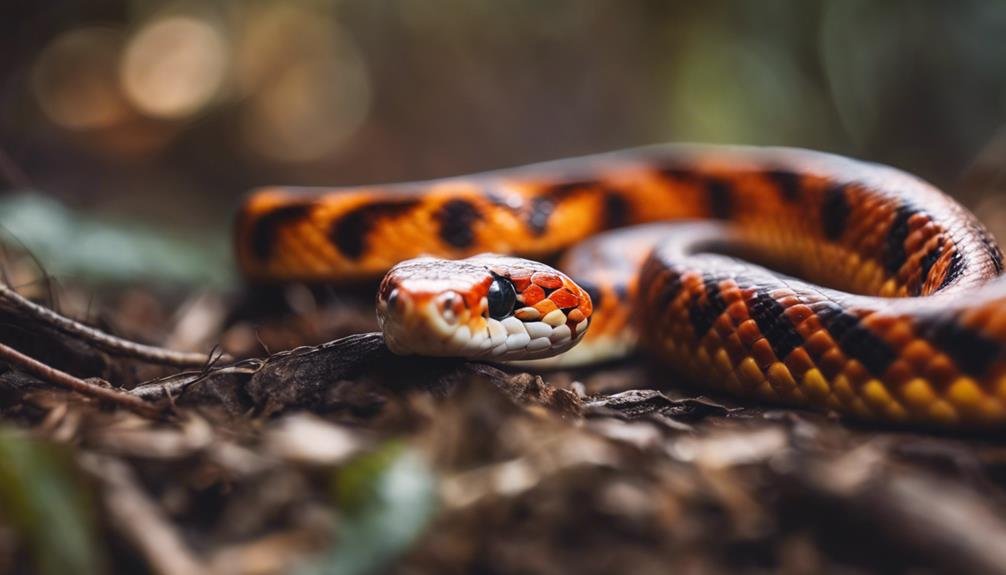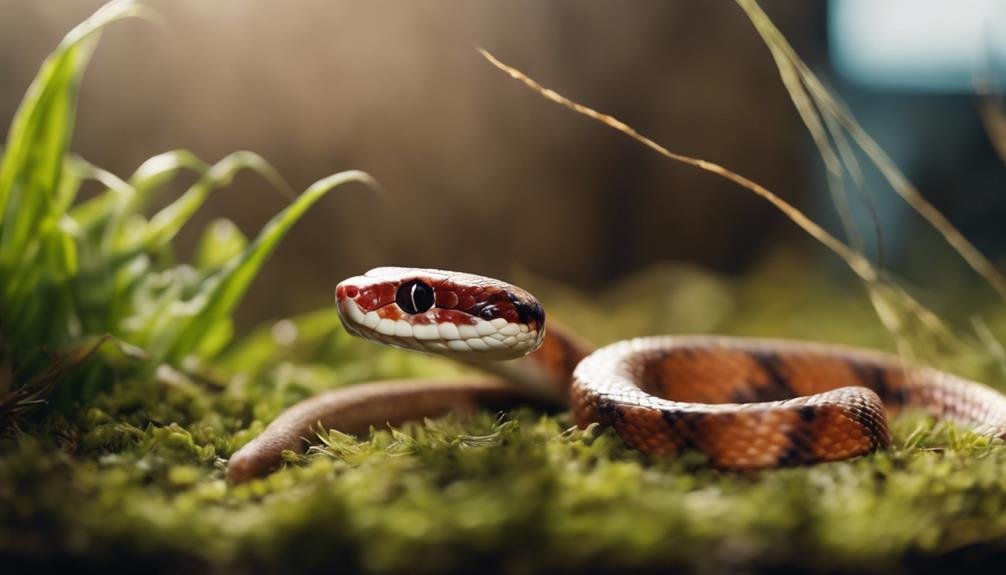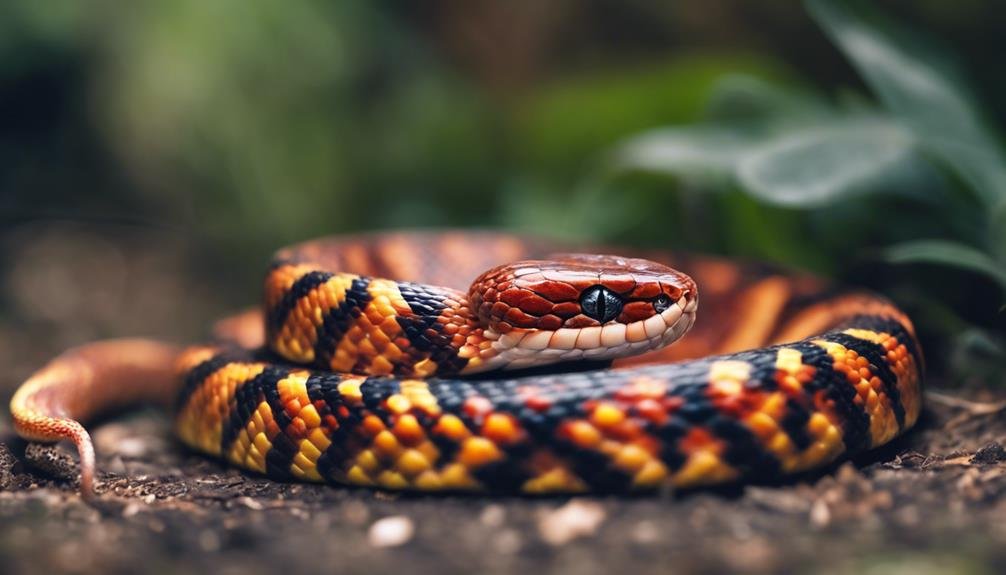You might wonder how corn snakes, these seemingly gentle creatures, manage to survive in the wild without venom. Yes, they're constrictors, using a method that's as fascinating as it is efficient. They coil around their prey, gradually tightening their grip in a deadly embrace that cuts off blood flow, leading to suffocation. This behavior not only showcases their hunting prowess but also opens a window into the complex world of snake survival strategies. But there's more to their hunting methods and impact on the ecosystem than meets the eye, setting the stage for an intriguing exploration of their natural behavior and adaptations.
Key Takeaways
- Corn snakes employ a constriction technique to subdue their prey, similar to rat snakes.
- They coil tightly around their prey, gradually increasing pressure to cause suffocation.
- This hunting behavior is efficient, energy-saving, and does not rely on venom.
- Constriction allows them to tackle and immobilize larger meals effectively.
- In the wild, corn snakes use this method primarily on small mammals and birds, swallowing their prey whole after immobilization.
Corn Snake Taxonomy
Understanding the taxonomy of corn snakes, classified as Pantherophis guttatus, sheds light on their fascinating evolutionary journey and unique biological traits. You're diving into the domain of a species of snake that not only captivates with its beauty but also intrigues with its place in the natural world. As a member of the family Colubridae, corn snakes belong to a group known for their non-venomous status, distinguishing them from their more dangerous relatives.
Their taxonomic classification places them within the subfamily Colubrinae, emphasizing their relation to mostly non-venomous snakes and highlighting their evolutionary link to rat snakes, specifically Elaphe obsoleta. This close relationship underscores their shared characteristics and divergent paths, offering insights into the adaptive strategies that have enabled them to thrive across various environments.
The journey through the taxonomic classification of corn snakes isn't just an academic exercise; it's a window into understanding their evolutionary relationships and biological characteristics. By exploring their place in the vast family Colubridae, you're gaining a deeper appreciation for these remarkable reptiles, their survival mechanisms, and their ecological significance. This exploration into their taxonomy isn't just about placing them in a scientific category; it's about unraveling the story of their existence and the intricacies that make them unique.
Natural Hunting Behavior
In their natural habitats, corn snakes employ a powerful constriction technique to hunt and subdue their prey. Much like their relatives, the rat snakes, corn snakes are constrictors. This means they use their bodies to wrap around their prey tightly. They don't rely on venom to catch or kill. Instead, they've developed a hunting behavior that's both efficient and effective without it.
When they catch a meal, they immediately start wrapping themselves around it. With every breath the prey takes, corn snakes tighten their grip. This isn't just about squeezing; it's a calculated method. They're ensuring that with each contraction, the prey's blood flow is restricted more and more. This process continues until the prey can no longer breathe and ultimately succumbs.
This hunting behavior showcases how corn snakes have adapted to their environment. They've mastered the art of constriction, enabling them to take down prey much larger than what you'd expect from such a slender snake. Their approach to hunting is a demonstration of the effectiveness of constriction as a method for non-venomous snakes to secure a meal.
Constriction Technique Explained


Let's explore how corn snakes employ their constriction technique to subdue prey effectively. As constrictors, these snakes have developed a hunting technique that's both efficient and energy-saving. When they encounter their prey, corn snakes quickly spring into action, using their bodies to wrap around the unfortunate animal. This isn't a gentle hug; they coil tightly, applying significant pressure.
The key here is the tightening of these coils whenever the prey exhales. This gradual increase in pressure prevents the prey from taking in new air, leading to suffocation. It's a non-venomous method, making corn snakes a fascinating example of how nature finds varied ways to accomplish the task of feeding.
Constriction isn't just about overpowering prey; it's a strategic move. By constricting, corn snakes can tackle meals larger than their heads, something that's essential for their survival and growth. This method also minimizes the prey's ability to fight back, reducing the snake's risk of injury. It's a smart, energy-conserving strategy that showcases the efficiency of corn snakes as constrictors in the wild.
Prey Selection and Strategy
Corn snakes meticulously choose their prey, focusing on small mammals and birds that they can overpower and consume efficiently. Their strategy isn't just about strength; it's about smart prey selection and using constriction to their advantage. This approach guarantees they can enjoy a variety of prey without expending unnecessary energy.
Here's how they do it:
- Size and Accessibility: They target prey that's easy to manage. Small mammals like rats and mice, along with birds, are perfect because they're the right size for constriction and ultimately, consumption.
- Quick Strike: Corn snakes are fast. They strike their prey swiftly, minimizing the chance for escape.
- Constriction: Once they've got their prey, they coil around it tightly. This isn't just squeezing; it's a calculated method to cut off blood flow and prevent breathing, ensuring the prey is subdued quickly and efficiently.
- Swallowing Whole: After the prey is immobilized, corn snakes swallow it whole. Their ability to consume a wide variety of prey whole is a reflection of their adaptability and efficiency as predators.
Adaptations for Survival


Adaptations for survival have equipped corn snakes with specialized muscles and skeletal structures, enabling them to efficiently constrict their prey. As constrictors, they've evolved to master this technique, which allows them to subdue their food without the need for venom. This is particularly important because it targets small rodents, which are abundant and essential for their diet. By coiling their bodies tightly around their prey, they suffocate it, making it easier to swallow whole.
This method of constriction isn't just about catching food; it's also about preserving energy and minimizing the risk of injury. Hunting can be a dangerous endeavor for any predator, but corn snakes have a significant advantage. Their ability to constrict means they can immobilize their prey quickly and efficiently. This reduces the chances of struggling and potential harm, ensuring they can continue to hunt and survive in their environment.
Moreover, by relying on constriction rather than venom to capture their meals, corn snakes play an important role in controlling rodent populations. This method of hunting isn't only effective but also guarantees they can sustain themselves without exhausting their resources or facing unnecessary dangers.
Impact on Ecosystem
How do corn snakes influence the balance of ecosystems they inhabit? These slender, non-venomous constrictors play a pivotal role in maintaining the health and stability of their environments. By controlling rodent populations, they not only contribute to ecosystem balance but also aid in reducing agricultural damage and the spread of diseases. Here's a closer look at their impact:
- Control of Rodent Populations: By preying on small mammals like mice and rats, corn snakes keep these populations in check, preventing the overconsumption of crops and stored grains.
- Reduction in Disease Spread: With fewer rodents, the risk of diseases that could affect both humans and wildlife decreases, promoting a healthier environment.
- Contribution to the Food Chain: As prey for larger predators such as foxes, owls, and hawks, corn snakes are integral to the biodiversity of their ecosystems.
- Regulation of Prey Populations: Their hunting strategies help prevent overgrazing by herbivorous prey, ensuring the survival of various plant species and contributing to overall biodiversity.
Do Breeding Seasons Affect Corn Snakes’ Hunting Mechanisms?
The breeding habits of corn snakes do impact their hunting mechanisms. During mating season, they may focus more on finding a mate than hunting for prey. This could lead to changes in their hunting behavior and efficiency. Understanding these seasonal changes is important for their care in captivity.
Captivity Vs. Wild Hunting


You'll find that the hunting behavior of corn snakes changes dramatically from the wild to captivity. In their natural habitat, they're active hunters, employing sophisticated techniques to catch live prey.
Whereas in captivity, they adjust to eating pre-killed food provided by their owners.
Let's explore how captive feeding practices, wild hunting techniques, and diet adaptation differences shape the life of these fascinating reptiles.
Captive Feeding Practices
In captivity, corn snakes are typically fed pre-killed or frozen-thawed rodents, contrasting sharply with their wild counterparts who hunt and constrict live prey like mice and birds. This method is chosen to guarantee the safety and well-being of the snake, preventing any potential injuries that might occur during a live hunt. Here's why captive feeding practices are important:
- Safety: Pre-killed and frozen-thawed rodents eliminate the risk of injury to the snake.
- Health: It ensures the snake receives a diet free from parasites that live prey might carry.
- Convenience: Offering pre-killed prey simplifies feeding time for the owner.
- Ethics: It avoids the ethical concerns some have regarding live feeding in captivity.
Understanding these practices helps in maintaining the health and welfare of pet corn snakes.
Wild Hunting Techniques
While captive feeding practices focus on safety and convenience, wild corn snakes exhibit fascinating hunting techniques that highlight their adaptability and skill. In the wild, these snakes rely on constriction as their primary method to capture and subdue prey. This technique involves wrapping their bodies around the prey to cut off blood flow and prevent breathing, leading to immobilization.
It's not just about strength; it's about efficiency. By constricting their prey, corn snakes make sure they can swallow their meals with ease, compensating for their lack of venom. This behavior isn't lost in captivity, as corn snakes retain their natural instincts to constrict, showcasing their inherent ability to adapt and efficiently capture prey in any environment.
Diet Adaptation Differences
Corn snakes experience a notable shift in diet adaptation when comparing their wild hunting habits to those in captivity. Here's how:
- Wild Diet: In their natural habitat, corn snakes hunt live prey, primarily small rodents like rats and mice, using their constricting abilities.
- Captive Feeding: In captivity, they're typically fed pre-killed rodents, which eliminates the need for them to use their natural hunting and constricting behaviors.
- Hunting Skills: Wild corn snakes use constriction to subdue their prey, a critical survival skill that mightn't be fully developed in captive snakes due to their adapted feeding practices.
- Behavioral Impact: This diet adaptation can significantly impact their natural hunting mechanisms, potentially affecting their behavior and health in captivity.
Conclusion
In essence, you've learned that corn snakes are skilled constrictors, adept at using their bodies to overpower prey. They've honed a hunting strategy that's both efficient and effective, targeting small mammals and birds.
This approach not only showcases their vital adaptability but also highlights their significant role in the ecosystem. Whether in the wild or captivity, their predatory behaviors remain consistent, underlining the importance of understanding these fascinating creatures and their contributions to our natural world.


